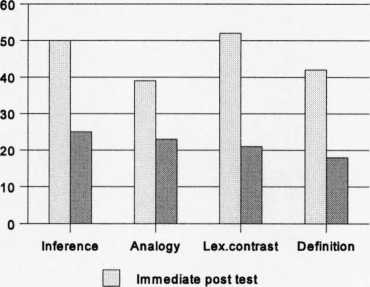p<.005; De: Z=2.8, p<.005). The same pattern was also found for the Lexical contrast group
during the immediate post test (Kruskal-Wallis I-Way Anova: X2= 8.5, df=2, p<.05). Post
hoc analysis revealed that the 6 year olds performed significantly better than the 4 year olds
(Mann-Whitney: Z=2.7, p<.005). Significant differences were also found for the Definition
group (Kruskal-Wallis I-Way Anova: X2= 7.4, df=2, p<.05). Post hoc analysis revealed that
the 6 year olds performed significantly better than the 4 year olds. A trend for significance
for the above pattern, was found for the Analogy group.
To what extent does children ,sperformance in the naming task differ by linguistic condition?
If all children from each linguistic condition (48 participants) were correct on the two target
words, the maximum total score would be 96 for each linguistic condition in each post test.
Figure 5.3 demonstrates children’s performance on the naming task by linguistic condition
for both post tests. The following figure shows that during the immediate post test, the
children from the Lexical contrast and Inference conditions performed better than the
children from the Definition and Analogy conditions.
Figure 5.3 Total number of correct responses on the naming task by linguistic
condition for both post tests

і.....I Delayed post test
Children’s responses were analysed using two analyses of variance (ANOVAs) with score
in the naming task as the dependent factor and type Oflinguistic condition as the independent
factor. During the immediate post test, the children from the Lexical contrast and Inference
conditions, performed better than the children from the other conditions. Furthermore, during
the delayed post test the children from the Inference and Analogy conditions performed better
than the children from the Lexical contrast and Definition conditions. However, a trend for
significance characterised the above findings.
115
More intriguing information
1. Literary criticism as such can perhaps be called the art of rereading.2. Governance Control Mechanisms in Portuguese Agricultural Credit Cooperatives
3. Types of Cost in Inductive Concept Learning
4. Towards Teaching a Robot to Count Objects
5. The name is absent
6. Land Police in Mozambique: Future Perspectives
7. The name is absent
8. The name is absent
9. The name is absent
10. Education Research Gender, Education and Development - A Partially Annotated and Selective Bibliography